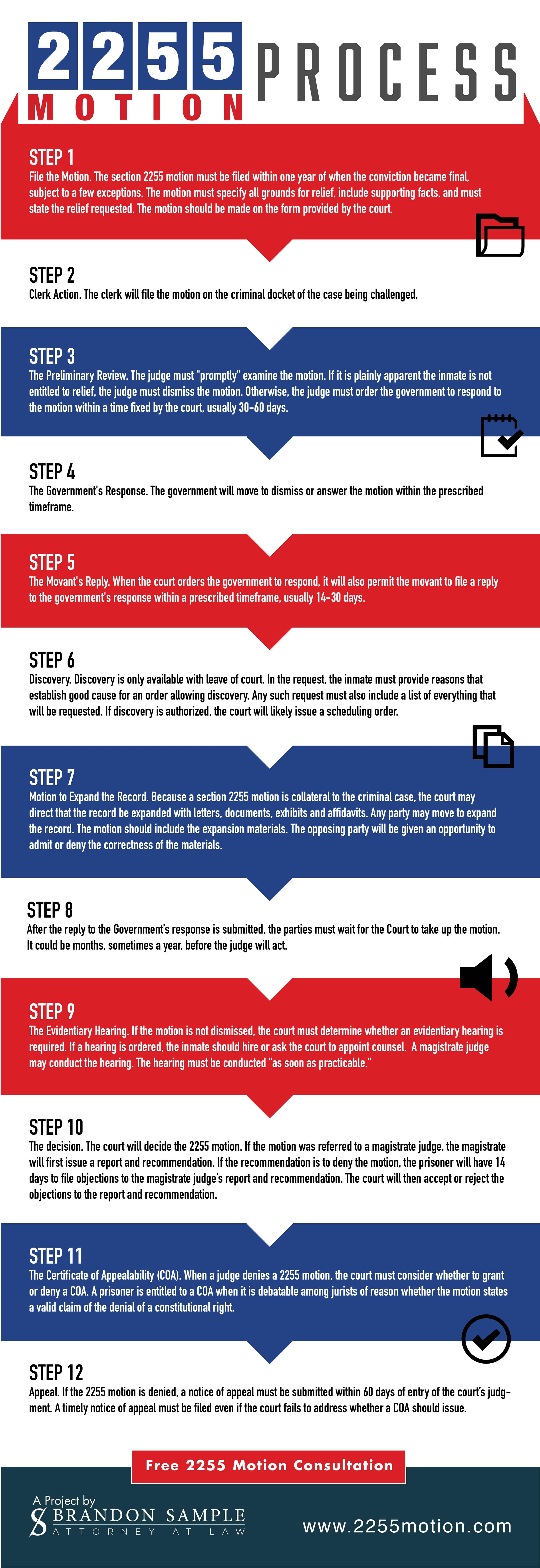2255 Motion Process Infographic
To help you understand the 2255 motion process, we present the following infographic which explains all of the steps in federal habeas corpus proceedings:

Share This 2255 Motion Process Infographic On Your Site
<p><strong>Please include attribution to 2255Motion.com with this graphic.</strong><br /><br /><a href=’https://2255motion.com’><img src=’https://2255motion.com/wp-content/uploads/2019/03/2255Motion.com-Infographic.jpg’ alt=’2255 Motion Process | Habeas Corpus’ width=’2432′ height=’7056′ border=’0′ /></a></p>
If you are having a hard time reading the above text, please see the companion text below:
Step 1: File the Motion. The section 2255 motion must be filed within one year of when the conviction became final, subject to a few exceptions. The motion must specify all grounds for relief, including supporting facts, and must state the relief requested.
Step 2: Clerk Action. The clerk will file the motion on the criminal docket of the case being challenged.
Step 3: The Preliminary Review. The judge must “promptly” examine the motion. If it is plainly apparent the inmate is not entitled to relief, the judge must dismiss the motion. Otherwise, the judge must order the government to respond to the motion within a time fixed by the court, usually 30-60 days.
Step 4: The Government’s Response. The government will move to dismiss or answer the motion within the prescribed timeframe.
Step 5: The Movant’s Reply. When the court orders the government to respond, it will also permit the movant to file a reply to the government’s response within a prescribed timeframe, usually 14-30 days.
Step 6: Discovery. Discovery is only available with leave of court. In the request, the inmate must provide reasons that establish good cause for an order allowing discovery. Any such request must also include a list of everything that will be requested. If discovery is authorized, the court will likely issue a scheduling order.
Step 7: Motion to Expand the Record. Because a section 2255 motion is collateral to the criminal case, the court may direct that the record be expanded with letters, documents, exhibits and affidavits. Any party may move to expand the record. The motion should include the expansion materials. The opposing party will be given an opportunity to admit or deny the correctness of the materials.
Step 8: After the reply to the Government’s response is submitted, the parties must wait for the Court to take up the motion. It could be months, sometimes a year before the judge will act.
Step 9: The Evidentiary Hearing. If the motion is not dismissed, the court must determine whether an evidentiary hearing is required. If a hearing is ordered, the inmate should hire or ask the court to appoint counsel. A magistrate judge may conduct the hearing. The hearing must be conducted “as soon as practicable.”
Step 10: The Decision. The court will decide the 2255 motion. If the motion was referred to a magistrate judge, the magistrate will first issue a report and recommendation. If the recommendation is to deny the motion, the prisoner will have 14 days to file objections to the magistrate judge’s report and recommendation. The court will then accept or reject the objections to the report and recommendation.
Step 11: The Certificate of Appealability (COA). When a judge denies a 2255 motion, the court must consider whether to grant or deny a COA. A prisoner is entitled to a COA when it is debatable among jurists whether the motion states a valid claim of the denial of a constitutional right.
Step 12: Appeal. If the 2255 motion is denied, a notice of appeal must be submitted within 60 days of entry of the court’s judgment. A timely notice of appeal must be filed even if the court fails to address whether a COA should issue.
If you have other questions about 2255 motions or other federal habeas corpus matters, please contact us for a free 2255 motion consultation. Our experienced habeas corpus attorneys are ready and able to help you understand the 2255 motion process and what options you may have.
